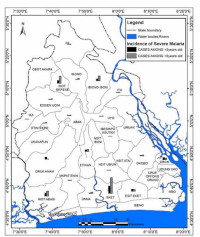Analysis of the Distribution Pattern of the Incidence of Malaria Disease In Akwa Ibom State, Nigeria
Main Article Content
Abstract
This study analyzed the distribution pattern of the incidence of malaria disease in Akwa Ibom State, Nigeria using geographic information systems techniques. Data on the incidence of malaria in the area was collected from secondary source-mainly from the Ministry of Health, Akwa Ibom State. The data was mapped using statistical and choropleth mapping techniques in a GIS environment. The result indicated that, they were seven categories of malaria disease in the area. Out of this number, three were high in number of cases and wide spread and could be regarded as major. Furthermore, out of the three major categories studied, two were randomly distributed and the distribution pattern of one of the categories clustered. The development and use of GIS for mapping to enhance targeting the sick was one of there commendations to eradicate/reduce the incidence of malaria disease in the Study area.
Downloads
Article Details
Section

This work is licensed under a Creative Commons Attribution-NonCommercial 4.0 International License.
How to Cite
Share
References
1. Adeboyejo, A. T., Lirvhuwani, M., & Shonisani, D. K. (2012). Impact of climate change on children’s health in Limpopo Province, South Africa. International Journal of Environmental Research and Public Health, 9.
2. Aliya, E. (2022). Children of today are leaders of tomorrow. Youth & Children’s Water Forum hosted by UNICEF in Dushanbe, 6th June, 2022. UNICEF.
3. Chukwuocha, U. M. (2012). Malaria control in Nigeria. Primary Health Care, (03).
4. Daum, A. C. (2013). Children of today, leaders of tomorrow, the overlooked generation of jihad. Senior Thesis, Liberty University.
5. Dougnon, T. V., Bankole, H. S., Hounmanou, Y. M. G., Echebiri, S., Atchade, P., & Mohammed, J. (2015). Comparative study of malaria prevalence among travelers in Nigeria (West Africa) using slide microscopy and a rapid diagnosis test. Journal of Parasitology Research, Article ID 108707:4. https://doi.org/10.1155/2015/108707
6. Epstein, A., Namuganga, J. F., Nabende, I., et al. (2023). Mapping malaria incidence using routine health facility surveillance data in Uganda. BMJ Global Health, 8, e011137. https://doi.org/10.1136/bmjgh-2022-011137
7. Gallup, J. L., & Sachs, J. D. (2001). The economic burden of malaria. American Journal of Tropical Medicine and Hygiene, 64(1–2), 85–96.
8. Getis, A., & Ord, J. K. (1992). The analysis of spatial association by use of distance statistics. Journal of Geographical Analysis, 24, 3.
9. Hay, S. I., & Snow, R. W. (2006). The Malaria Atlas Project: Developing global maps of malaria risk. PLoS Medicine, 3(12). www.plosmedicine.org
10. Kaur, H., Sehgal, R., Kumar, A., Sehgal, A., Bharti, P. K., Bansal, D., Mohapatra, P. K., Mahanta, J., & Sultan, A. A. (2019). Exploration of genetic diversity of Plasmodium vivax circumsporozoite protein (Pvcsp) and Plasmodium vivax sexual stage antigen (Pvs25) among North Indian isolates. Malaria Journal, 18(1), 308. https://doi.org/10.1186/s12936-019-2939-z
11. Krefis, A. C., Schwarz, N. G., Nkrumah, B., Acquah, S., Loag, W., Oldeland, J., Sarpong, N., Adu-Sarkodie, Y., Ranft, U., & May, J. (2011). Spatial analysis of land cover determinants of malaria incidence in the Ashanti Region, Ghana. PLoS ONE.
12. Mills, A., Lubell, Y., & Hanson, K. (2008). Malaria eradication: The economic, financial and institutional challenge. Malaria Journal, 7(S1), S11.
13. Mitchell, A. (2005). The ESRI Guide to GIS Analysis (Vol. 2). ESRI Press.
14. Odhiambo, J. N., Kalinda, C., & Macharia, P. M. (2020). Spatial and spatiotemporal methods for mapping malaria risk: A systematic review. BMJ Global Health.
15. Okeke, E. U. (2012). Nigerian malaria: The problems and the fight. Malaria Journal.
16. Olagundoye, K., & Goparaju, L. (2023). Spatial analysis and mapping of malaria risk areas using multicriteria decision making in Ibadan, Oyo State, Nigeria. Journal of Geography and Cartography, 6(2). https://doi.org/10.24294/jgc.v6i2.2214
17. Onah, I. E., Adesina, F. P., Uweh, P. O., & Anumba, J. U. (2017). Challenges of malaria elimination in Nigeria: A review. International Journal of Infectious Diseases and Therapy, 2(4), 79–85.
18. Robinson, A. H., Morrison, J. L., Muehrcke, P. C., Kimerling, A. J., & Guptill, S. C. (1995). Elements of Cartography. New York: John Wiley.
19. Sachs, J., & Malaney, P. (2002). The economic and social burden of malaria. Nature, 415, 680–685.
20. Selvaraj, P., Suresh, J., Wenger, E. A., Bever, C. A., & Gerardin, J. (2019). Reducing malaria burden and accelerating elimination with long-lasting systemic insecticides: A modelling study of three potential use cases. Malaria Journal.
21. United Nations (UN). (2020). Ending Poverty. United Nations.
22. Walker, C. (2016). Tomorrow's leaders and today's agents of change? Children, sustainability education and environmental governance. Children & Society, 31(1), 72–83. https://doi.org/10.1111/chso.12192
23. World Health Organization (WHO), & UNICEF. (2003). Africa Malaria Report. Geneva: WHO.
24. World Health Organization (WHO). (2002). World Health Report 2002. https://www.who.int/whr/2002/en/
25. World Health Organization (WHO). (2011). The World Health Report 2011. Geneva: WHO. https://www.who.int
26. World Health Organization (WHO). (2012). Global Malaria Programme: World Malaria Report. Switzerland. Available at: http://www.who.int/malaria/publications/world_malaria_report_2012/report/en/
27. World Health Organization (WHO). (2018). World Malaria Report 2018. Geneva: WHO. 166 p.
28. World Health Organization (WHO). (2020). World Malaria Report 2020. Geneva: WHO.
29. World Health Organization (WHO). (2021). World Malaria Report 2021. Geneva: WHO.
30. World Health Organization (WHO), Roll Back Malaria (RBM), & UNICEF. (2005). World Malaria Report 2005. Geneva: WHO.


